
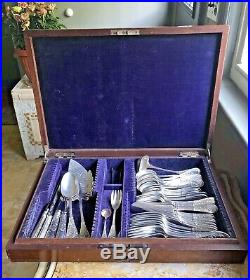
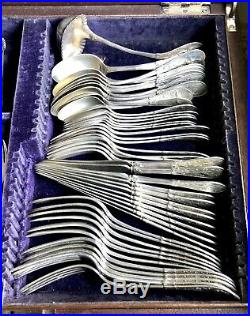
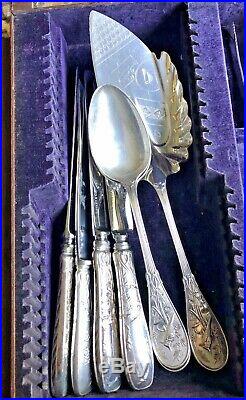
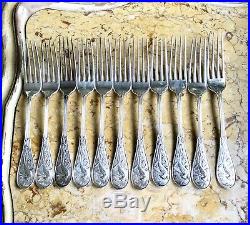
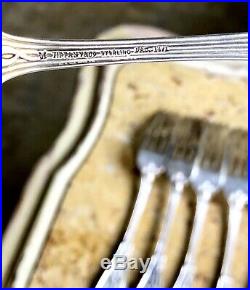

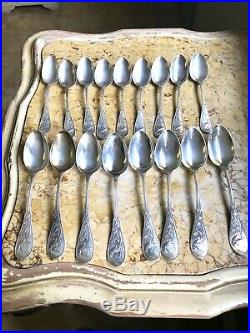
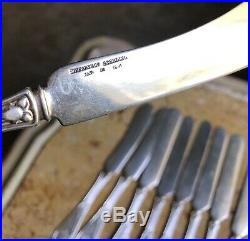

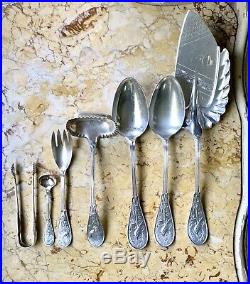
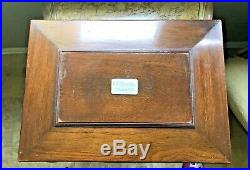


This listing is for a very beautiful and luxurious Tiffany & Co antique Japanese pattern flatware set that has four Audubon pieces, and comes in a period wooden case, also made by Tiffany. Are all dated 1871 (148 years old) , and the Audubon pieces, which have a similar design, are just signed Tiffany & Co Sterling. The latter are contemporary to the 2000’s. The set has an ethereal quality. Japanese was conceived during the period when Louis Comfort Tiffany was a leader in the Arts Nouveau Movement, and the firm reflected his esthetic, with the Tiffany Studios’ peerless art glass, incredible lamp works, and breathtaking jewelry pieces. Designed by award-winning silversmith John C. Moore, it was i nspired by nineteenth-century paintings and culture. The Japanese pattern has an organic Art Nouveau period design, with flora and fauna in relief front and back. Eight different avian species and flowers are depicted. This is a collection of such pieces from different venues over the years. Most pieces bear differing monograms – as shown in picture eight of the lunch forks. Although the monograms differ, the effect is harmonious due to the fancy script. The Tiffany hallmark on the reverse. Japanese pieces are marked. M TIFFANY & CO PAT. Audubon pieces are marked. This set consists of 54 Japanese pieces and 4 Audubon knives, as listed below. Item Length Quantity Pattern. Luncheon Forks 7 1/8. Junior Knife 7 3/4. Steak Knife 9 3/4 1 Audubon. Serving Spoons 8 1/2. I use the luncheon knives for all meals, and the luncheon forks as desserts as well. The tablespoons double as soups or dessert spoons. The dinner forks are quite large, so I will use one or two as servers for meat or vegetables as well. The fish knives are elegant and wavy: so they are suitable as butter or cheese servers as well. The fish server has detailed engraved designs on the spatula-like area, including clams, scrolls, books, and what looks like Mt Fuji with a sun and moon in the background. The case is solid wood, single tiered, and lined in deep purple velvet. It has metal fittings, and is inscribed near the closure: TIFFANY & Co 550 & 552 B’WAY. The key is missing and the section where a key would insert into the lock appears to be missing the little plate. There is a metal plaque on the top of the case that bears the following inscription: J. Partridge 23 August 1869. Case dimensions: length 19 inches, width 13 1/2 inches, height 2 1/2 inches. I’m not certain what type of wood it is made of, but its smells good when you open it. Whether you’re hosting a romantic. Fête, an intimate dinner party, or planning a family celebration. This set would lend an exotic accent to the coming holiday festivities. A memorable gift for the person that has everything, or a cherished item for the nature lover, it is destined to become a family heirloom that evokes good memories of you and your home. Ave enjoyed it with much love and laughter over the years. It has good karma! All pieces are in good antique condition with normal wear due to use over the years. The only exceptions are the gravy. Ladle, which has a couple of small dents in the bowl and a teaspoon or two that may have a ding in the bowl. The decorations that adorn the pieces are still crisp: not rubbed or worn. There are no splits, cracks or restorations. Two dinner forks have had monograms removed at Tiffany’s. The case exterior shows substantial shelf wear as commensurate with age. No tears or stains to the interior velvet. It may be refurbished by Tiffany & CO, however, it will better retain its value if preserved with its original finish. Comes from a smoke-free home. All sales are final. Japanese was designed in 1871, during the most innovative period in the history of Tiffany silver, and it is still one of the most popular of all Tiffany patterns. Japanese was the first Tiffany pattern to introduce silver decorated in the Japanese revival style. The flowing designs of branches and twigs with leaves, buds, flowers and exotic birds were entirely different from anything in American silver at that time. This pattern was a direct result of the interest in exotic cultures that became widespread in the late nineteenth century. This interest led directly into the American Art Nouveau movement, whose leader was Louis Comfort Tiffany, son of Tiffany’s founder. Each piece of Audubon is decorated with intricate designs adapted from nineteenth century Japanese bird paintings, with eight species represented. The back of each piece has complementary designs derived from Japanese flowers. Japanese’s exquisite detail lends itself well to a wide range of table-setting designs from traditional to contemporary. A Legacy of Sterling Silver. With striking new designs or with new flourishes to renowned patterns, Tiffany silver graces the home now as it has since 1837 with an unparalleled tradition of excellence. From the time he founded Tiffany & Co. Moore to make hollowware pieces. Moore was instructed to follow the standard for English sterling-925 parts per 1,000 parts silver-which was the standard eventually adopted by the United States. Tiffany later merged operations with Moore, who soon enlisted the help of his son, Edward. The younger Moore would become the guiding force behind Tiffany’s silverware business for the next forty years. The rapid expansion of wealth in America created a demand for silver objects, which was further fueled by the discovery of extensive silver deposits in the West. Tiffany crafted the abundant metal into opulent designs that epitomized the sumptuous décor and dining habits of the Gilded Age. The varied motifs were derived from Moore’s vast design library. His countless volumes on architecture, horticulture and metallurgy, as well as collections of Japanese lacquer, Islamic glass, Middle and Far Eastern tiles and textiles, and European porcelains, formed the basis of the Tiffany School, America’s first school of design. The silver designs inspired by Moore’s library won top awards at the world’s fairs of the late 19th century. At the 1878 Paris fair, Tiffany was awarded the Grand Prize for Excellence, the first given to an American silversmith. Much attention was paid to the company’s innovative Japanesque-style silver, designs of a refined simplicity with hammered surfaces, applied three-dimensional flora and fauna, and inlaid mixed metals. Unsurpassed in the history of American silver, Tiffany’s Japanesque silver had an important and modernizing influence on American and European decorative arts. Tiffany’s silver entry at the 1878 fair also included the spectacular Mackay dinner-and-dessert service for 24, one of the most elaborate silver table services ever produced. Created from a half-ton of silver sent by prospector John Mackay from his Comstock Lode mines in Nevada, the 1,250-piece service, including hollowware and flatware, was developed from flower-encrusted Persian and Indian motifs, with thistles, shamrocks, and American flowers. The service took two years and 200 craftsmen to complete. These historic achievements established Tiffany as the unchallenged master of American silver design and represent the highest standards of quality and craftsmanship that direct Tiffany silversmiths today. The company’s hollowware workshop, Tiffany & Co. Makers, located in Parsippany, New Jersey, is one of a few remaining producers of hand-wrought silver in the United States. The collections, including intricate and skill-intense statement silver, define the art of contemporary entertaining and decorating. Tiffany’s silver legacy gleams in candlesticks, tea sets and trays, vases, bowls, pitchers, plates and a wealth of accessories in such acclaimed patterns as Chrysanthemum c. 1880, the most ornate of any American silver pattern, with flowing curves and blossoming plants that prefigure Art Nouveau; Audubon c. 1871, adapted from 19th century bird paintings; Arts & Crafts, accented with copper rivets and carved jade finials; and in tribute to a seminal Tiffany collection, Japanesque silver, hand hammered and chased, with mixed metals in detailed, naturalistic patterns. The company’s celebrated flatware patterns include Century, created in 1937 to commemorate the company’s 100th anniversary; and Bamboo, introduced in 1965 and winner of the International Design Award. Each design represents the rich heritage of Tiffany silver that for generations has welcomed guests into beautifully appointed homes and cast a lustrous glow over life’s most memorable occasions. The item “TIFFANY CO STERLING JAPANESE & AUDUBON FLATWARE Service 4 8 58-Pc Birds & Flora” is in sale since Friday, June 12, 2020. This item is in the category “Antiques\Silver\Sterling Silver (.925)\Flatware & Silverware”. The seller is “tainadorisa” and is located in Essex Fells, New Jersey. This item can be shipped to United States.
- Brand: Tiffany & Co.
- Age: 1850-1899
- Featured Refinements: Tiffany Sterling Silverware
- Type: Flatware – Sets
- Style: Art Nouveau
- Pattern: Japanese Bird
- Composition: Sterling Silver

